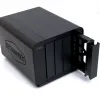Software Installation
Installing software on a Network Attached Storage (NAS) device involves a few straightforward steps that integrate the NAS into your existing network, configure it, and prepare it for use. The process starts by ensuring that the NAS is connected to the same network as your other devices, including your computer. To facilitate the initial setup, you can utilize a network scanning application like FING on your smartphone to discover the NAS's IP address, which is assigned automatically via DHCP by your router.
An alternative approach involves using a dedicated mobile application provided by the NAS manufacturer. This app simplifies the process by automatically detecting any TerraMaster NAS units on the network when the app is running. The subsequent configuration steps are largely streamlined through TerraMaster's TNAS and TOS software suites, designed to make the setup user-friendly and accessible.
One of the notable features of many NAS devices, including those from TerraMaster, is their support for hot-swapping hard drives. This means that if a drive was not installed at the initial power-up, the user can insert it later and simply run a "re-check" command within the TNAS software to integrate the drive without restarting the device.
After the TOS installation, the NAS will reboot to apply the new settings and proceed to the next phase of the setup. This phase involves inputting basic information such as password, naming the device, and setting the correct time zone. These initial settings help secure the NAS and integrate it with your network environment.
The final steps in the NAS setup involve configuring administrative settings, which include verifying your email address as 2FA to receive a code necessary for completing the setup. This step may require navigating through interfaces in different languages, depending on the detected user or system settings. Once the administrative setup is complete, you can configure a HSS/SSD, RAID array and file system according to your storage needs. Today we'll just use one M2 SSD though.
TerraMaster's Network Attached Storage (NAS) devices operate under TOS 5.1, consistent with other models in this series. Despite announcements hinting at the imminent release of TOS 6.0, the current version remains unchanged. TOS distinguishes itself from other Linux-based NAS operating systems by its ongoing development status, which has resulted in a user experience that may not be as refined or complete with apps as competitors such as Synology's DSM or Asustor's ADM.
Challenges for TerraMaster have historically centred around system security and transitioning between different NAS models. However, following vulnerabilities exploited by Denial of Service (DOS) attacks, enhancements have been made to fortify TOS against widely recognized security threats. I'd rate the brand as very secure these days.
The anticipated TOS 6.0 is anticipated to be a significant update, compatible with a broad range of existing TerraMaster hardware. Substantial efforts have been invested in the development of TOS 6.0, including the long-awaited introduction of software tools. These tools, some of which are still in a Beta testing phase, have experienced delays in their release.




